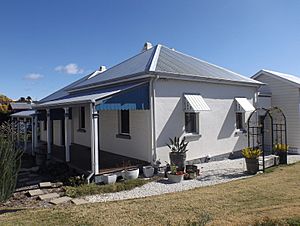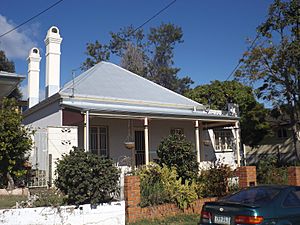Bess Street Brick Cottages facts for kids
Quick facts for kids Bess Street Brick Cottages |
|
|---|---|

Cottages in 2015
|
|
| Location | 22, 25-27 Bess Street, Windsor, City of Brisbane, Queensland, Australia |
| Design period | 1870s - 1890s (late 19th century) |
| Built | c. 1880 - 1930s circa |
| Official name: Bess Street Brick Cottages, Hedge's Buildings | |
| Type | state heritage (built) |
| Designated | 15 December 2000 |
| Reference no. | 601834 |
| Significant period | 1880s-1930s (fabric) 1880s (historical) |
| Significant components | residential accommodation - maisonette/s / duplex, kitchen/kitchen house, residential accommodation - main house |
| Lua error in Module:Location_map at line 420: attempt to index field 'wikibase' (a nil value). | |
The Bess Street Brick Cottages are old homes in Windsor, Brisbane, Australia. They are special because they are heritage-listed, meaning they are important to history. These cottages were built around 1880 and are also known as Hedge's Buildings. One of them is a duplex, which means it's a building with two separate homes inside. They were added to the Queensland Heritage Register in 2000.
Contents
History of the Bess Street Cottages
These small brick cottages were built in the late 1870s or early 1880s. They were likely built by Samuel Hedge, who owned a brickyard in the nearby Lutwyche area.
The Story of Samuel Hedge and Brickmaking
In 1859, a large piece of land in Lutwyche was bought by Sarah Sophia Bartley. Later, in 1870, Samuel Hedge bought about 4 acres of this land. Samuel Hedge and his son, Francis John Hedge, were well-known brickmakers in Lutwyche from at least 1878. They made bricks until the early 1890s. Samuel Hedge lived on Bess Street in the 1880s.
Brickmaking was one of the first big industries in Brisbane. In the 1870s and 1880s, many brickyards were found in the Lutwyche and Kedron areas. Other famous brickmakers there included William Anderson and John Salt. Even today, a street nearby called Brickfield Street reminds us of the brickmaking history.
Building Homes for Brickmakers
In 1877, Samuel Hedge divided his 4 acres of land into 20 smaller blocks. He also created a new street, which became known as Bess Street. He sold most of these blocks between 1878 and 1886. However, he kept the land where 20, 22, and 25-27 Bess Street are today.
It seems Samuel Hedge divided the land to provide homes for workers. Many people living on Bess Street in the 1880s were working-class. A lot of them were connected to the brickmaking industry. For example, some residents were brickmakers, draymen (who drove carts), and carpenters. This shows how important the brickyards were to the local community.
In 1998, both 22 and 25-27 Bess Street were recognized as important historical places by the Brisbane City Council.
Looking at 22 Bess Street
The land for 22 Bess Street was sold by Samuel Hedge in 1881. The brick cottage there was built close to the eastern edge of the property. This suggests that Samuel Hedge might have started building it. He might have planned to make it a duplex, like the one across the street at 25-27 Bess Street. But he sold the property before finishing it.
The house was owned by the Qualtrough family for about 30 years. They rented it out to others. In 1920, Janet Watters bought the house. She lived there through the 1920s. It looks like she updated the cottage, adding a sleeping verandah and a bathroom on the western side. She also added beautiful plaster decorations inside.
Exploring 25-27 Bess Street
Samuel Hedge kept ownership of 25-27 Bess Street until 1899. He then transferred it to his daughter, Caroline Aspinall. Caroline didn't live there herself but rented out the two homes. She owned them until she passed away in 1935.
Later, in 1950, two families, the Imries and the Perrys, bought 25-27 Bess Street together. The Perrys made some changes to their side of the duplex (27 Bess Street) in the 1950s and 1960s. They enclosed the front verandah and built a garage.
What Do the Cottages Look Like?
The Bess Street Cottages are on opposite sides of Bess Street in Windsor.
25-27 Bess Street is a duplex. This means it's one building with two separate homes inside. They share a wall in the middle. These two homes were built around 1880.
Diagonally across the street is 22 Bess Street. This is a single brick cottage, also built around 1880. It has a newer extension from the 1920s made of timber and fibrous-cement.
Another brick cottage, 20 Bess Street, is next to 22 Bess Street. It was also a duplex once but has been changed a lot into one home. This building is not part of the heritage listing. All the cottages are built close to the street, with small front yards.
Inside 22 Bess Street
This cottage has four main rooms, with later additions and updates from the 1920s. The main part of the house is made of brick and sits on stone foundations. It has an iron roof. There's a front verandah that was added more recently. The outside brick walls are covered to look like cut stone.
On the eastern side, there are two chimneys built into the wall. This suggests that the original plan might have been to build a duplex here, just like 25-27 Bess Street. At the back, a newer kitchen and dining room replaced an older back verandah. On the western side, there's a sleeping verandah from the 1920s. It has a cool geometric pattern on its top edge, like Art Deco style.
Inside, the house still has its original layout. The 1920s extension and newer back additions are easy to see. The main part has a living room, a dining room, and two bedrooms. The living room and dining room each have a fireplace. The house has beautiful plaster ceilings and decorations from the 1920s. The floors are made of timber.
Inside 25-27 Bess Street
25-27 Bess Street is a brick duplex. Each home in the duplex is similar to 22 Bess Street. They each have four main rooms and sit on stone foundations. They have iron roofs. Both homes have enclosed front verandahs, which are not exactly the same. They also have older timber kitchen houses at the back and enclosed back verandahs.
The outside walls of the duplex are covered. But the original front and back walls were made of face brickwork, which is now painted. Inside, both homes have plastered walls and mostly old timber floors. The ceilings in most rooms have newer fibrous cement sheets. However, one bedroom in 27 Bess Street still has its original wide timber ceiling boards. Each home used to have a fireplace in the dining room, but the chimneys are gone now.
Why Are These Cottages Important?
The Bess Street Brick Cottages were added to the Queensland Heritage Register in 2000. This means they are very important to Queensland's history.
- Showing History: These cottages, built around 1880, show how the Kedron/Lutwyche/Windsor area became a major brickmaking center in Brisbane. They were likely built by brickmaker Samuel Hedge for his workers. This connects them closely to an important early industry in Brisbane.
- Rare and Special: These cottages are a rare group of 19th-century brick homes for working-class families that still exist in Queensland. They are special because not many like them are left. Also, 25-27 Bess Street is a rare example of a single-story brick duplex from the 1880s in Brisbane.
- Good Examples: Both 22 and 25-27 Bess Street are still mostly in their original condition. They show us what these types of homes looked like back then.
- Beautiful Design: 22 Bess Street adds beauty to the street. The inside of 22 Bess Street, with its 1920s Art Deco-inspired plasterwork, is a great example of its style and is very beautiful.


